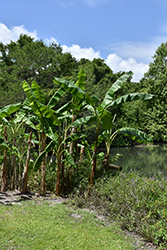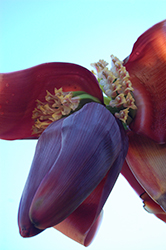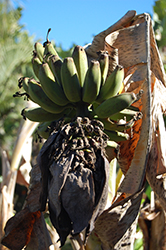Fri & Sat 8am - 8pm
Sun 8am - 7pm
Anytown, USA 12345
fax: 261.787.0463
e-mail: info@successgc.com


Plant Finder

Height: 25 feet
Spread: 10 feet
Sunlight:
![]()
Hardiness Zone: 9a
Other Names: Musa acuminata x balbisiana
Description:
A sterile triploid that was developed primarily to produce tasty yellow fruit; many cultivars have been developed from this hybrid; yellow flowers with purple-red bracts appear in summer, followed by tasty, sweet fruit; a perfect accent or container plant
Edible Qualities
Edible Banana is a perennial that is commonly grown for its edible qualities, although it does have ornamental merits as well. It produces yellow oblong bananas (which are technically 'berries') with white flesh which are typically harvested when mature. The bananas have a sweet taste and a soft texture.
The bananas are most often used in the following ways:
- Fresh Eating
- Cooking
- Baking
Features & Attributes
Edible Banana's attractive enormous glossy oval leaves remain green in color throughout the year on a plant with an upright spreading habit of growth. The fruits are showy yellow bananas carried in abundance in early fall.
This is an herbaceous evergreen perennial with an upright spreading habit of growth. Its wonderfully bold, coarse texture can be very effective in a balanced garden composition. This plant will require occasional maintenance and upkeep, and should never be pruned except to remove any dieback, as it tends not to take pruning well. It has no significant negative characteristics.
Aside from its primary use as an edible, Edible Banana is sutiable for the following landscape applications;
- Accent
- Vertical Accent
- Hedges/Screening
- General Garden Use
- Container Planting
Planting & Growing
Edible Banana will grow to be about 25 feet tall at maturity, with a spread of 10 feet. It has a low canopy with a typical clearance of 5 feet from the ground. It grows at a fast rate, and under ideal conditions can be expected to live for approximately 30 years. As an evegreen perennial, this plant will typically keep its form and foliage year-round.
Bananas are curious plants in a botanical sense. Strictly speaking they are perennials, with individual shoots rising up from underground rhizomes and maturing in one to two years, then ultimately dying after producing fruit, to be replaced by new shoots from the base. However, given their ultimate size and coarseness they almost behave as small trees in the landscape. This plant should only be grown in full sunlight. It does best in average to evenly moist conditions, but will not tolerate standing water. This plant should not require much in the way of fertilizing once established, although it may appreciate a shot of general-purpose fertilizer from time to time early in the growing season. It is not particular as to soil type or pH. It is somewhat tolerant of urban pollution. This particular variety is an interspecific hybrid.
Edible Banana is a good choice for the edible garden, but it is also well-suited for use in outdoor pots and containers. Its large size and upright habit of growth lend it for use as a solitary accent, or in a composition surrounded by smaller plants around the base and those that spill over the edges. It is even sizeable enough that it can be grown alone in a suitable container. Note that when growing plants in outdoor containers and baskets, they may require more frequent waterings than they would in the yard or garden.


